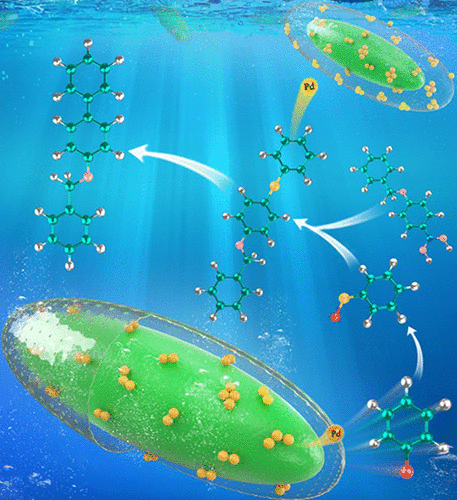当前位置:
X-MOL 学术
›
J. Am. Chem. Soc.
›
论文详情
Our official English website, www.x-mol.net, welcomes your
feedback! (Note: you will need to create a separate account there.)
Confirmation of Suzuki-Miyaura Cross-Coupling Reaction Mechanism through Synthetic Architecture of Nanocatalysts
Journal of the American Chemical Society ( IF 14.4 ) Pub Date : 2020-07-15 , DOI: 10.1021/jacs.0c04804 Bo Sun 1 , Lulu Ning 2 , Hua Chun Zeng 1
Journal of the American Chemical Society ( IF 14.4 ) Pub Date : 2020-07-15 , DOI: 10.1021/jacs.0c04804 Bo Sun 1 , Lulu Ning 2 , Hua Chun Zeng 1
Affiliation

|
Despite widespread use of heterogeneous Pd catalysts in Suzuki-Miyaura coupling reactions, detailed roles of Pd, especially the nature of its active species are still a topic of controversy debate. While some studies showed active surface of Pd nanoparticles or nanoclusters acting heterogeneously, others claimed soluble Pd species leached from the metallic Pd to be active species which are homogeneous in nature. Besides, within the homogeneous mechanism, how the Pd leaches and promotes the cross-coupling reaction is then another question needed to be addressed. It could be envisioned that if the soluble Pd species and solid-phase Pd are physically separated, the mechanism of Suzuki-Miyaura coupling could then be confirmed through examining the catalytic activity in different reaction regions. Herein we use microporous Stӧber silica as a membrane to separate the soluble Pd species from solid Pd and conduct size-selective reactions which allow the passage of leaching Pd species, but not of reactants or products larger than the membrane aperture. With this strategy, we have been able to differentiate the surface reaction from the solution cross-coupling. We find that the leached Pd species are the only genuine catalytic intermediate in the cross-coupling reactions. We also confirm that oxidative addition of aryl halides to the solid Pd leads to leaching of the soluble Pd species which is necessary to promote Suzuki-Miyaura reactions.
中文翻译:

通过纳米催化剂的合成结构确认 Suzuki-Miyaura 交叉偶联反应机制
尽管在 Suzuki-Miyaura 偶联反应中广泛使用了多相 Pd 催化剂,但 Pd 的详细作用,尤其是其活性物种的性质仍然是一个有争议的话题。虽然一些研究表明 Pd 纳米粒子或纳米团簇的活性表面不均匀,但其他研究则声称从金属 Pd 中浸出的可溶性 Pd 物种是本质上均质的活性物种。此外,在均相机制中,钯如何浸出并促进交叉偶联反应是另一个需要解决的问题。可以设想,如果可溶性 Pd 物质和固相 Pd 物理分离,则可以通过检查不同反应区域的催化活性来确认 Suzuki-Miyaura 偶联的机制。在此,我们使用微孔 Stӧber 二氧化硅作为膜,将可溶性 Pd 物质与固体 Pd 分离,并进行尺寸选择性反应,允许浸出 Pd 物质通过,但不允许反应物或大于膜孔径的产物通过。通过这种策略,我们已经能够将表面反应与溶液交叉耦合区分开来。我们发现浸出的 Pd 物种是交叉偶联反应中唯一真正的催化中间体。我们还证实,芳基卤化物向固体 Pd 的氧化加成导致可溶性 Pd 物质的浸出,这是促进 Suzuki-Miyaura 反应所必需的。通过这种策略,我们已经能够将表面反应与溶液交叉耦合区分开来。我们发现浸出的 Pd 物种是交叉偶联反应中唯一真正的催化中间体。我们还证实,芳基卤化物向固体 Pd 的氧化加成导致可溶性 Pd 物质的浸出,这是促进 Suzuki-Miyaura 反应所必需的。通过这种策略,我们已经能够将表面反应与溶液交叉耦合区分开来。我们发现浸出的 Pd 物种是交叉偶联反应中唯一真正的催化中间体。我们还证实,芳基卤化物向固体 Pd 的氧化加成导致可溶性 Pd 物质的浸出,这是促进 Suzuki-Miyaura 反应所必需的。
更新日期:2020-07-15
中文翻译:

通过纳米催化剂的合成结构确认 Suzuki-Miyaura 交叉偶联反应机制
尽管在 Suzuki-Miyaura 偶联反应中广泛使用了多相 Pd 催化剂,但 Pd 的详细作用,尤其是其活性物种的性质仍然是一个有争议的话题。虽然一些研究表明 Pd 纳米粒子或纳米团簇的活性表面不均匀,但其他研究则声称从金属 Pd 中浸出的可溶性 Pd 物种是本质上均质的活性物种。此外,在均相机制中,钯如何浸出并促进交叉偶联反应是另一个需要解决的问题。可以设想,如果可溶性 Pd 物质和固相 Pd 物理分离,则可以通过检查不同反应区域的催化活性来确认 Suzuki-Miyaura 偶联的机制。在此,我们使用微孔 Stӧber 二氧化硅作为膜,将可溶性 Pd 物质与固体 Pd 分离,并进行尺寸选择性反应,允许浸出 Pd 物质通过,但不允许反应物或大于膜孔径的产物通过。通过这种策略,我们已经能够将表面反应与溶液交叉耦合区分开来。我们发现浸出的 Pd 物种是交叉偶联反应中唯一真正的催化中间体。我们还证实,芳基卤化物向固体 Pd 的氧化加成导致可溶性 Pd 物质的浸出,这是促进 Suzuki-Miyaura 反应所必需的。通过这种策略,我们已经能够将表面反应与溶液交叉耦合区分开来。我们发现浸出的 Pd 物种是交叉偶联反应中唯一真正的催化中间体。我们还证实,芳基卤化物向固体 Pd 的氧化加成导致可溶性 Pd 物质的浸出,这是促进 Suzuki-Miyaura 反应所必需的。通过这种策略,我们已经能够将表面反应与溶液交叉耦合区分开来。我们发现浸出的 Pd 物种是交叉偶联反应中唯一真正的催化中间体。我们还证实,芳基卤化物向固体 Pd 的氧化加成导致可溶性 Pd 物质的浸出,这是促进 Suzuki-Miyaura 反应所必需的。











































 京公网安备 11010802027423号
京公网安备 11010802027423号